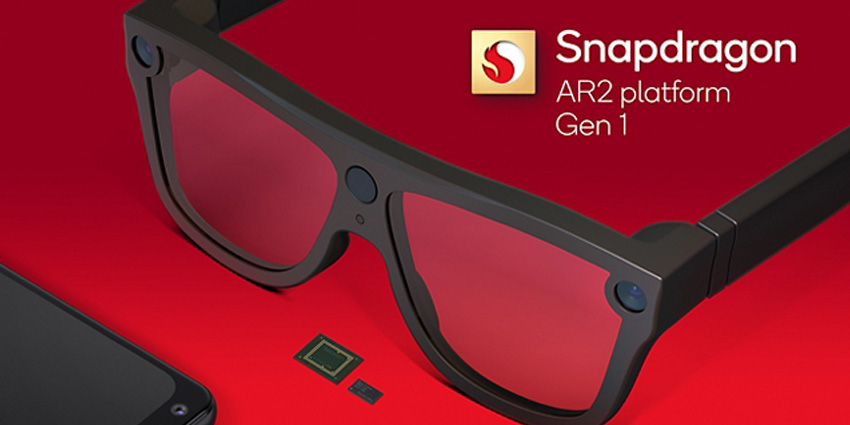The Immerse Global Summit 2022 Miami concluded on Wednesday, where some of the biggest players in the tech industry gathered to explore the future of Web3 technologies. Qualcomm Technologies has remained at the forefront of developing top-tier solutions for the global virtual, augmented, mixed, and extended reality (VR/AR/MR/XR) industry, with its latest solution designed for AR devices.
The San Diego, California-based firm has become synonymous with delivering XR solutions capable of untethering head-mounted displays (HMDs) from PC.
This has allowed companies to access standalone headsets with the latest specs along with major support for software development via the company’s Snapdragon Spaces platform.
XR Today spoke to Brian Vogelsang, AR Product Leader at Qualcomm, on the sidelines of the event about ongoing updates with its latest product release, the Snapdragon AR2 platform.
The AR2 is set to empower the smart glasses sector with an innovative, standalone, and sleek processing platform to deliver the next generation of smart glass devices.
XR Today: What have been your biggest takeaways from the IGS 2022 Miami?
Brian Vogelsang: My biggest takeaway has been the excitement across the industry. It’s been a challenging couple of years due to the pandemic.
The tech industry responded by rallying as a community and a group. It was amazing to get together with everyone and see renewed interest and engagement.
XR Today: Qualcomm recently debuted its Snapdragon AR devices platform. What are its features and what it aims to achieve?
Brian Vogelsang: The AR2 is in its first generational stage in a series of processors to enable AR. We wanted to help facilitate lightweight, wearable glasses with comfortable form factors, allowing people to use them for longer periods of time.
We also wanted to unlock that capability in AR smart glasses and spent some time thinking about achieving such goals. Qualcomm concluded that it needed to build dedicated processors for AR.
Previously, we had built XR processors for VR and AR, but through our engineering efforts and researching market demand, we realised it needed dedicated processing and spent several years working on the technology.
The platform contains multiple processing chips and we think it will empower both enterprise and consumer AR smart glasses with form factors capable of achieving mass adoption.
XR Today: Do you believe AR or VR will drive mass adoption across the XR industry? What are your general thoughts on this?
Brian Vogelsang: Over the past couple of years, we’ve seen tremendous adoption of VR for commercial use cases in verticals like health and wellness, training and immersive learning, and others.
VR has gone through a rapid transition from a primarily consumer-focused, tethered device for gaming and entertainment, to standalone headsets in similar verticals.
Before 2019, headsets were largely tethered to PCs, and Qualcomm helped to ‘cut the cord’ and enable the next evolution of standalone devices.
This began with devices from Lenovo, HTC VIVE, Pico Interactive, and Meta Platforms, so the growth we’ve seen for consumer use cases has been very strong since then.
The AR market has been primarily focused on assisted reality, or devices with monocular displays and sometimes cameras, but are wearable computers for tasks such as remote guidance.

With it, experts can see what you see to guide professionals with step-by-step work instructions via a micro display similar to Google Glass or Vuzix. Other devices from Magic Leap and Microsoft’s HoloLens headsets offer deeper levels of immersion.
We saw an opportunity to create a new category between the two with devices featuring AR viewers. These are AR smart glasses that are tethered to smartphones, which debuted in 2019.
The smart glasses tether via a USB cable to process most of the computing on the smartphone and content is viewed on the head-mounted displays (HMDs).
We also developed perception technologies for hand, eye, and position tracking in the physical environment. This allowed smart glasses and smartphones to synchronise seamlessly.
These are devices like the Lenovo A3 and similar, and we think that is the future. With the AR2, we wanted to determine how to make truly wireless devices and enable broader adoption of immersive technologies for enterprises and consumers.
XR Today: Snapdragon Spaces has been one of the major driving forces behind accelerating the XR industry. Can you tell us more about this?
Brian Vogelsang: Snapdragon Spaces is Qualcomm’s way of delivering technologies for original equipment manufacturers (OEMs). We’re now bringing that directly to developers, who can download the software development kit (SDK) for Unity or Unreal Engine.
Developers can gain access to its deep AR, perception, hand-tracking, 3D reconstruction, and other technologies. These allow them to create experiences on our devices and we are excited to work with the developer community on these technologies.
We made them generally available in June this year and, more recently, announced its expansion to support not just AR, but also VR and MR. With Snapdragon Spaces, we support optical see-through AR smart glasses. These range from the Lenovo A3 [and Magic Leap 2]. We’re also expanding into MR and AR, allowing developers to build an AR device with greater interoperability with MR headsets.
Final Thoughts on the Future of XR, AR Devices
Vogelsang added he was enthusiastic about the momentum across the XR industry and community. Along with its efforts with the AR2 and Snapdragon Spaces, the Meta Quest Pro, Lenovo VRX, Magic Leap 2, and Pico 4 and Pico 4 Enterprise had announced along with a “new wave of headsets.”
He concluded that future AR2-enabled glasses were on the way, so the community was “ramped up about” it and Qualcomm was “ready to build for this as well.”
The IGS 2022 Miami took place 5 to 7 December at Miami Beach’s iconic Fontainebleau Hotel and united some of the world’s most renowned tech firms for the future of XR.
Companies such as Meta Platforms, Lenovo, Magic Leap, Qualcomm, Unity Technologies, Sony, and many others attended the event to explore the future of immersive technologies, host workshops, and launch panel discussions on Web3 solutions reshaping the future of computing.







